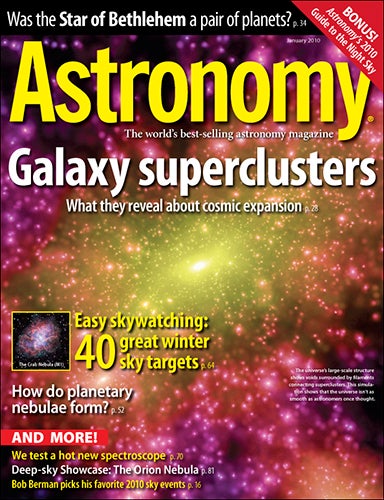
Editor David J. Eicher gives a video tour of the January 2010 issue
WAUKESHA, Wis. — On scales of hundreds of millions of light-years or less, our universe is a random, confounding pattern of matter and voids. Although voids make up most of the volume, matter is strung along filaments that glisten with galactic pearls. Enmeshed in this cosmic web are individual galaxies, galaxy clusters, and even more mystifying, agglomerations of galaxy clusters called “superclusters.”
In “What galaxy superclusters tell us about the universe,” Bruce Dorminey explains how astronomers are working to better understand this cosmic web of the universe’s large-scale structures — how they formed and how they influence cosmic expansion.
“It’s not just the pattern of galaxy superclusters, but how they form, evolve, and are linked across the sky that bewilder cosmologists,” Dorminey writes. “And that’s before considering more esoteric aspects of supercluster distribution, such as: What does this seemingly random distribution of cosmic matter tell us about the universe’s ultimate nature or our own role in the cosmic sea?”
To learn more about the methods used to study superclusters and what scientists have learned because of them, pick up the January issue of Astronomy, on newsstands December 1.
“What was the Star of Bethlehem?”
Many are familiar with the story of the Star of Bethlehem, a star in Christian tradition that revealed the birth of Jesus to wise men and led them to Bethlehem. But which star was it, if it was actually a star at all? In “What was the Star of Bethlehem?” Senior Editor Michael E. Bakich rules out several candidates for the sight that appeared to the wise men and explains what leading sky events remain.
“Target 40 wonderful winter sky treats”
The winter sky is loaded with great deep-sky targets, and Astronomy constantly gets requests to write about them. So, in “Target 40 wonderful winter sky treats,” Astronomy Senior Editor Michael E. Bakich offers up 12 star clusters, 13 nebulae, 11 galaxies, and four miscellaneous objects to go after during those cold observing sessions.
“2010 Guide to the Night Sky”
Astronomy‘s “2010 Guide to the Night Sky” is a four-page supplement to the January issue meant to tag along with you during your next 12 months of observing. It includes a chart of the lunar phases, observing summaries for some of the major solar system targets, and a full-page graphic explaining when all the planets will be visible in the sky during 2010. A center spread includes four maps depicting the night sky each season, each accompanied by descriptions of a few deep-sky highlights during that time.
Also in the January 2010 Astronomy
- “How do planetary nebulae form?” — Over the past decade, astronomers have cracked the code of planetary nebula shapes. Now we know why these stellar coffins appear in such a variety of intricate styles.
- “Tour the Fornax Supercluster” — Medium to large-aperture telescopes reveal dozens of galaxies in this small region of sky.
- “Astronomy tests a hot new spectroscope” — You may have seen sunspots and prominences, but have you observed the Sun’s spectrum? The Lhires Lite spectroscope makes such observations easy.
- “The Sky This Month” — Exclusive pullout star charts will guide you through January’s night sky.
- The January issue of Astronomy also includes Astro News, Beautiful Universe, Bob Berman’s Strange Universe, Glenn Chaple’s Observing Basics, David Levy’s Evening Stars, Stephen James O’Meara’s Secret Sky, Ask Astro, Astro Confidential, Deep-sky Showcase, New Products, and Reader Gallery.









